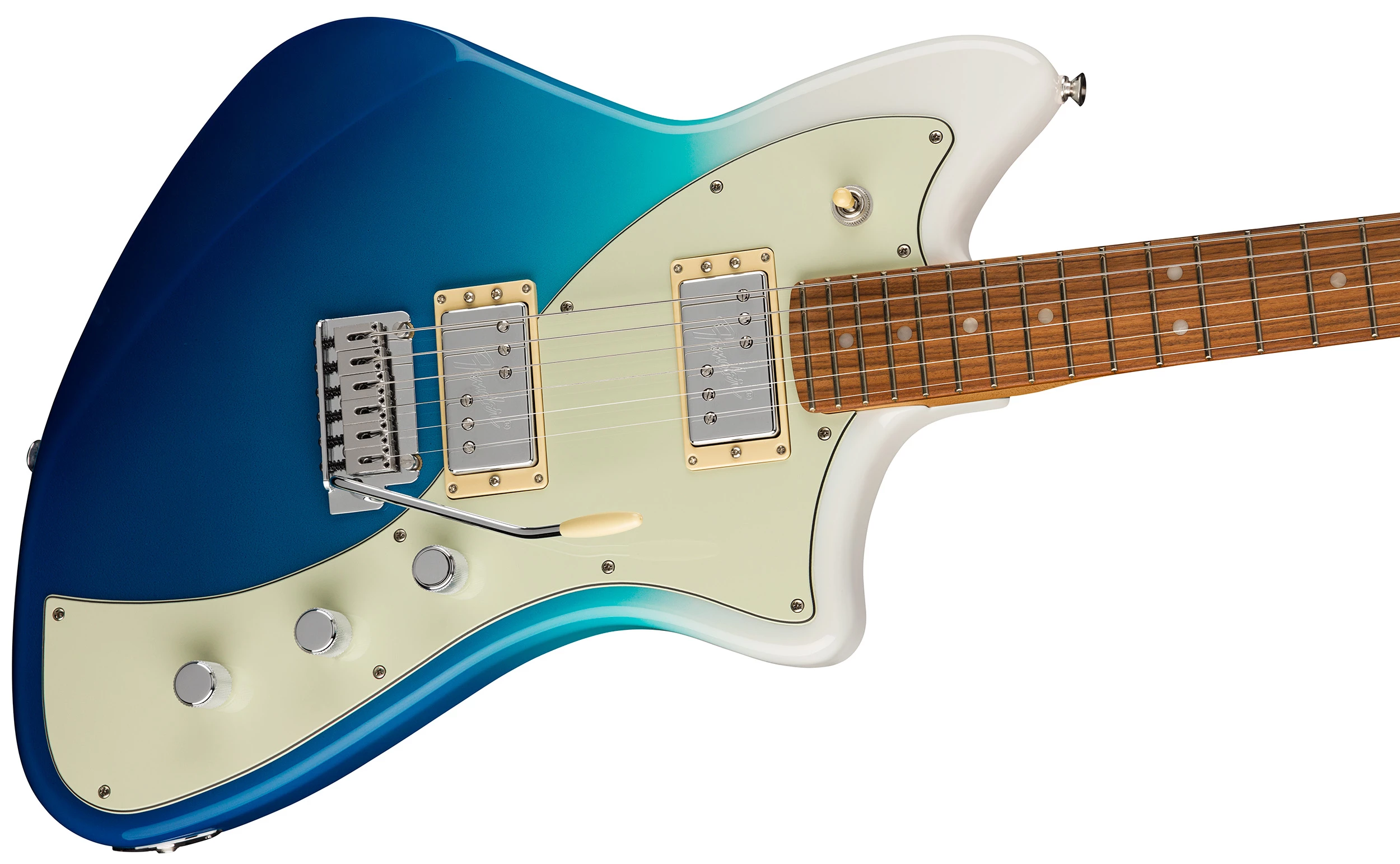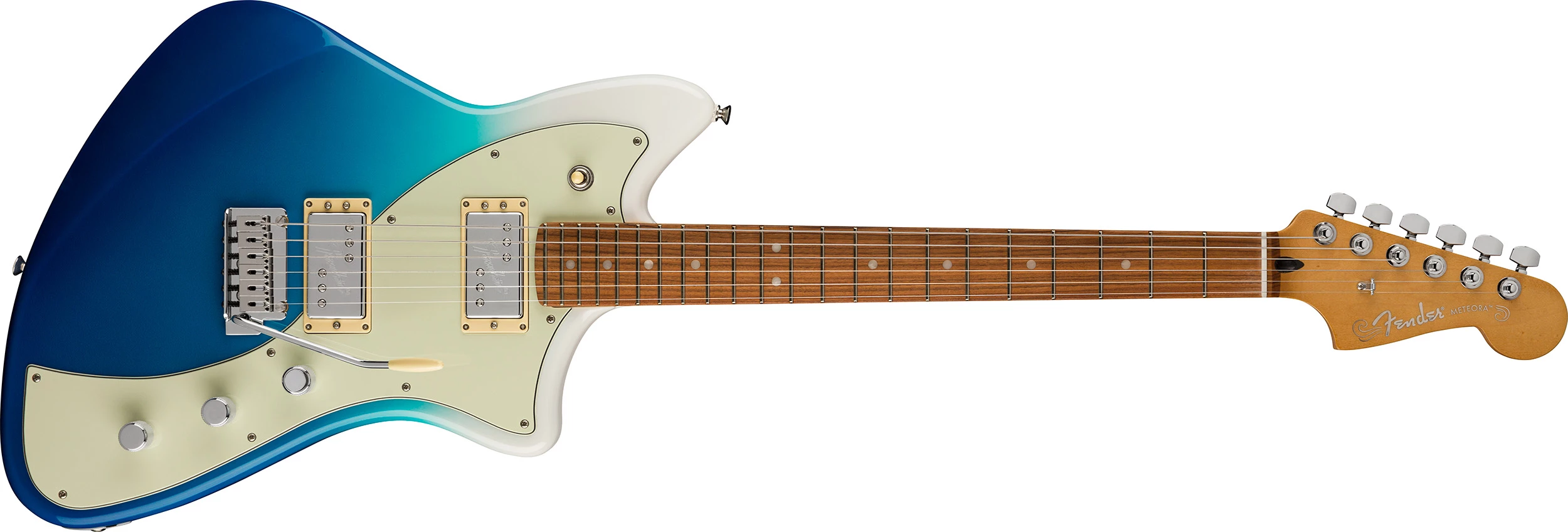Fender has released an ultra-versatile new guitar and bass into its Player Plus series. The Meteora HH will split opinions with its out-there, asymmetrical looks, but its all-new "Fireball" pickup system feels like an absolute classic in the making.
Our review guitar is the dual-humbucker Meteora HH, in a beachy "Belair Blue" gradient finish, with a Pau Ferro fingerboard. The body shape struck me as looking like a tweaked Jazzmaster, but Fender EVP of Product Justin Norvell tells me it's a clean-sheet design. "In the past, we've done a lot of hybrid designs combining disparate guitars, but the Meteora is truly somebody sitting down and sketching a new body shape. You're naturally going to end up with a top horn and maybe a cutaway on the bottom, some of those things that give it a Jazzmaster-like appeal. But out of the gate, it was really trying to find a new shape that looked plausible historically, yet still futuristic and not leaning too hard on the past."
The shape certainly feels like a statement, and it'll be interesting to see where it finds its place in the great mashup of fashion and music. But Fender has gone out of its way to make this a comfortable and friendly instrument to play. The alder body shape moves comfortably with you, either seated or standing, its a human-friendly shape, and there's easy access to the upper frets.

Since it launches in the Player Plus series, it's pitched at up-and-comers. Made in Mexico, it comes in at a price point below Fender's American-made gear, and ships with a gig bag instead of a hard case. But where the entry-level Player guitars are very basic, Player Plus axes get some nice higher-end touches as well as fancier paint jobs.
We're talking locking tuners for quick and easy string changes. Rolled edges on the fingerboard to make it feel like it's been "played in" fresh out of the box. A satin finish on the back of the "modern C" shaped neck to add to the sense of comfort as you move about. A two-point whammy bar with six block-steel saddles. A relatively flat 12-inch radius fretboard with 22 medium-jumbo frets – combine that with the light 9-gauge strings it ships with, and this is a ridiculously easy guitar to wail on and rip huge bends.
Between the body and the neck, this is a very inviting instrument to pick up, play, and keep playing. My only criticisms here would be that it's not lightweight, and might weigh on you by the end of a long gig, its pointy-curvy shape sits weirdly in guitar stands, and it's got an odd bottom-facing jack that never seems to be where you're looking for it.
Norvell tells me the Fender team spent six months working on the pickup system for this thing, and the resulting "Fireball" pickups are absolutely the standout highlight of this guitar for me. They're a pair of metal-covered humbuckers, with a three-position switch, a tone knob for each pickup, and a coil-split feature built into the volume knob as a push button. So effectively, there are six distinct tones available, and between them, they cover an enormous amount of sonic territory.

The dynamics here are extraordinary; these are some of the most expressive stock pickups I've had the pleasure of playing with. Put the Meteora in the neck position with the coils split, and you can go from crystal-clear piano chords to a spanky lead sound full of character and bite, without touching a dial. Move to the middle position and you can enjoy glassy feather-touch bell tones, or lay into the thing for a super-snappy, out-of-phase, quacky funk sound. Then there's the bridge, which rivals a tele for its bright, raucous country and rock sounds.
The single-coil sounds are legit, but popping the coil-split button back out gives you bigger, fuller, warmer versions of all these sounds, and with the humbuckers in there buckin' some hum, you can easily push the Meteora into super high gain rock and metal sounds.
But some things remain consistent: the dynamics are beautiful however you use this thing. The Fireballs can put out a lot of sound, but only if you lay into them. So they encourage you to be expressive with your right hand, and you really get a wonderful sense that you're driving the amp with your pick. If that doesn't suit what you're going for, higher output and more consistency of volume are only a pedal away. The sounds are bright, clear and articulate across the board as well; the Meteora does a very impressive job of rendering complex chords in a way that resists getting muddy and losing the interesting intervals, even when you're rocking out.
The Fireball pickups make this a hugely expressive instrument that encourages you to concentrate on your touch, without punishing a sloppy hand too badly. Every one of its vast range of tones is its own broad palette, and there's fresh inspiration available at the flick of a switch. It's a hard guitar to put down. We played it back-to-back with an 80s-era Lace sensor Strat Plus, a late-model American Pro Telecaster and a 90s Washburn N2. It held its own for tone and character against the Fender giants of the past through the clean and crunch channels, and yet chogged out nearly as hard as Washburn's funk-metal beast through the high-gain overdrive channel, but with broader dynamics and clearer chords. This guitar's range blew us away.
I ask Norvell whether these pickups will be available to slot into other guitars. "Probably in time," he says. "Right now, with all the supply chain issues going on, it's tough. So they'll be out there in the instruments for a while, but I'd expect them to show up in the aftermarket down the track."

It's not perfect, and there are some small quality disappointments that betray the fact that this is not a flagship product. The pickguard on our review unit is warped on arrival – you could either treat that as a feature, and wedge some spare pics in the bubbles, or pull it off and flatten it in ten minutes with a hairdryer, but it's the sort of thing that takes the shine off a bit. The jack's loose out of the box, so I've got to go digging around for imperial spanners for what should be a five-second step at the factory.
Likewise, it doesn't arrive set up, so unless you've got the time and inclination to do the intonation, the action, fiddle with polepiece heights, adjust the trem springs and that sort of thing, you might wanna budget some extra for a professional setup. For some reason, whoever's strung this thing has pulled the strings tight into the locking tuners without winding them around the pegs at all. One tuning knob must've been bumped during transport, so the B string pops out when I go to play it, and getting it back into the tuner is crazy difficult since there's no extra string at the end. And the high E string hasn't been run under the string tree on the head, so it pops and pings when I try to bend it, and then breaks within 20 minutes.
These are all very temporary issues, and possibly not common ones, but they do affect my first impression. Then there's the pickup switch, which feels a bit cheap. It's set straight up and down, and doesn't seem to want to rotate in its cavity to a more diagonal angle that I suspect would feel more natural to hit as you play. Also, I'm not a big tremolo bar guy, but this one feels a bit difficult to access without bumping your hand into the tone knobs. It does a decent enough job of holding things in tune, but as a floating system, you'll need to be prepared to retune all the strings to get it into drop D.
Still, I wouldn't be put off by any of these niggles. I think Fender has come up with a super impressive instrument here, with a thoroughly musical pickup system that I can see people wanting to put in all sorts of bodies when it hits the aftermarket. The neck and body are friendly, comfortable, easy and inviting to play, and those Fireballs deliver expressive, articulate, clear and hugely dynamic sound with genuine character and depth across a broad range of classic and modern tones. There's a lot to discover here, and a lot to love.
"The original designs of the Strat and Tele informed future music," says Norvell, "and there will always be people that gravitate to those guitars. The Meteora's future is unwritten, but as we put it out there, we're thinking of players that are a little more individualistic, and not as tied to the past. We wanted to offer a modernistic, forward-leaning palette, with humbucking pickups for people who play a little more aggressively, or who don't want that 60-cycle hum when they're recording at home. But like you say, it's hugely dynamic, so the range of who could or would use these is pretty wide. The right artists will gravitate towards these, and they'll write and record songs, and that'll influence what this becomes and who it'll be for."

The same body shape and approach has been applied to a Player Plus Meteora bass guitar design as well, including its own set of bass-specific Fireball humbucker pickups, which can be run either in passive mode for a more classic sound, or in active mode with 3-band EQ to access a broad range of more modern tones. It looks as versatile and impressive as the HH guitar.
The Fender Player Plus Meteora HH hits the market at US$1,149.99 (or AU$2,299 in Australia, €1149.00 in the EU, and £999.000 in the UK). The bass costs a little more, at US$1,199.99 ($2,399.00 in Australia, €1299.00 in the EU, £1,149.00 in the UK). Both offer relatively traditional sunburst and silverburst color options if you want to tone things down a little from that out-there shape, but the guitar lets you get a little nuts with a luminescent cosmic jade green, or this surfy belair blue, and the bass offers a fresh opal spark blue and an outrageous tequila sunrise if you're ready to make a statement.
Check out a pair of videos below.
Source: Fender
Thanks to Cory Jach and Chris Blain for their assistance with this review.















